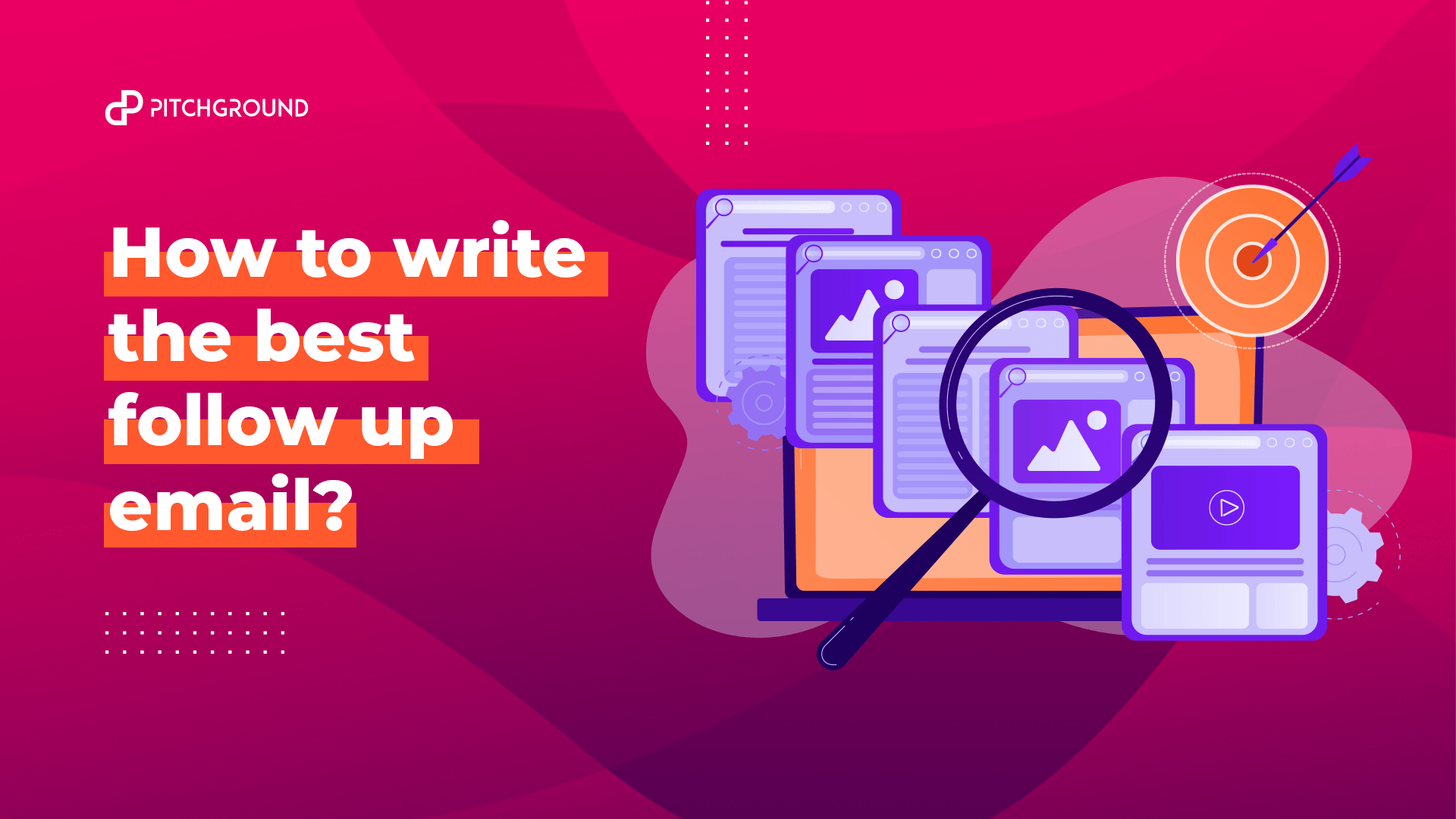“Let’s face it; most marketers don’t have the best reputation. We’re seen as being pushy and trying to sell people things they don’t want or need. It doesn’t help that when we do have something of value to share with our audience, we often come across like a used car salesman.” “However, there’s one thing that all successful marketers do well- follow up on their leads.” “A good follow-up email can be the difference between converting a lead into an opportunity or having them slip through your fingers forever.” “In this post, I’ll show you how to write the perfect follow-up email so you can start converting those leads into opportunities!”
What is a follow-up email?
A follow-up email is an email that you send to a lead (potential customer) who has been on your list for a certain period without taking action on the initial email you sent them when they were added to your email list. It should contain relevant and valuable content to engage the leads into taking the desired action. It can also be seen as email sequences sent if you want to re-engage with the lead or if that person did not respond to the initial email.
Why Are They So Important?
Don’t let your leads getaway; follow up with them! More than half of the people will never follow through with anything they see on the internet. Your follow-up email gives you another opportunity to make a great impression and convert that lead into an opportunity. With effective strategies, this is no longer an issue.
Why are these kinds of emails so important? They can be the difference between losing that lead and turning them into an opportunity. Think about it, if you follow up with your list of tips five times, there’s a good chance that a lot will follow through by taking the desired action.
If they don’t follow through, then they were just not meant to be on your list in the first place.
What Makes a follow-up email good?
It needs to have some essential elements and effective strategies for the email to be effective:
1) Relevant content to engage or remind the leads. It should be promoting something related to what the lead signed up for. This means that if you are sending out these kinds of emails to people who signed up for your list, the follow-up email should be related to that topic. Or, if you are sending follow-up emails out to leads who have not taken action yet on an offer or promotion, then the follow-up email should contain information about that offer/promotion. Related content is what will engage the follow-up email the most.
2) A call-to-action to follow up on the desired action. Without a call-to-action, your follow-up emails might as well not exist.* Your follow-up email should contain a clear and concise call to action (e.g., visit our website, follow us on Twitter, like our Facebook page, etc.).
3) Social proof. It is essential that once a lead does not go to the buying stage, you can show social proof. It will help that lead because it might show others struggling with something that they currently are. Convince them that this product or service will help them out.
*Note: For follow-up emails to be most effective, they should have a call-to-action that is different from the one in your initial follow-up email. For example, if you’re sending follow-up emails to an offer or promotion offering something for sale, then your follow-up email should not contain a call-to-action to purchase that item. You don’t want to be annoying and make yourself look desperate in an attempt to follow up on something.
When Should You Send a Follow-up Email?
Whenever you follow up with a lead, it is essential that you follow a few rules. You don’t want to send emails too often because you want the follow-up email to be relevant and valuable for your leads.
Sending emails too frequently will make your leads ignore your emails.
It will look desperate and unprofessional if you follow up on the same leads too often, especially within a short period.
These kinds of emails are most effective if they follow this schedule: follow up on the leads a few days after they sign up, follow up in 7-14 days, follow up with an event or promotion offer in 30-90 days (or whenever you see fit), follow up again 3 to 4 months later. After that, follow up again three months later.
For follow-up emails related to an event or promotion offer, follow up after the desired action has been taken (or expired).
A schedule like this will follow a pattern and not bother your leads too much. You want to follow up in a way that makes it look natural and not spammy.
What follow-up emails should you send out?
Some email examples could be the ones below. These email examples should give you an idea of what type of content you can send out.
Email #1: Send 30 minutes after the lead signs up. The follow-up email should be sent immediately because you want to encourage them to check out your landing page or website. You want the follow-up email that they receive within the first minutes of joining your list to be from you. This follow-up email should contain relevant content that encourages them to follow up with you, such as a link to the follow-up email or an incentive for subscribing.
Email #2: Send 7 – 14 days after they sign up. The follow-up email should follow up on the desired action from follow-up email #1. This follow-up email should be about the same topic as follow-up email #1, but it can also contain new information and follow up on something you mentioned in follow-up email #1. For example, if you send follow-up emails related to an event or promotion offer, follow up something you said in follow-up email #1 a week later.
Email #3: Send 30 days after follow-up email #2 and follow the same schedule as follow-up email #2 (e.g., send follow-up email 3 in a follow-up email #2’s program).
Email #4: Send three months after follow-up email #3 and follow the same schedule as follow-up email #3. A follow-up at this time could be a reminder to follow you on social media sites, subscribe to your blog, or read your latest blog post.
Email #5: Send a follow-up email after three months of follow-up #4 and follow the same schedule as follow-up email #4. This follow-up can be your last follow-up if you no longer want to attempt to communicate with this lead again.
What Should You Put in Your Follow-up Emails?
It can be a great way to keep in touch with your subscribers and lead without being too pushy or annoying. One follow-up that you should send out is an invitation to follow you on social media sites, subscribe to your newsletter or blog, follow up on the desired action.
After email #2 (and follow-ups following email #2), you can follow up with content related to the first email. This follow-up can be a review of something that you mentioned in the first email or information on how they can take advantage of the follow-up in follow-up email #1.
Create a Snappy Email Subject Line
Your subject line is crucial as it will directly impact whether or not the follow-up email gets read. The subject line should be short and to the point.
It should be immediately apparent what the email is about, especially when you consider that more than half of follow-up emails are opened on a mobile device. So, be sure that your subject line is short and isn’t overly complicated to read.
After you have checked the length of the follow-up email and the follow-up email’s subject line, test out different follow-up emails’ subject lines to see which follow-up email subject line gets the most opens.
An example follow-up email’s subject line might look something like this: “Time is running out! ” or “Customers have already found our website because of you!”
Below you can find a few subject line examples:
1) Use urgency in your follow-up email’s subject line. Urgency can produce a more robust follow-up open email rate and increase follow-up email click-through rates. ( Click here to find out how urgency works in follow-up email subject lines.)
2) Make follow-up email subject lines short and engaging.
3) Be specific! Use numbers, times, dates, etc., in follow-up email subject lines.
4) Avoid follow-up email subject lines that sound like you’re just trying to promote something.
5) Make follow-up email subject lines personal. Personal follow-up emails subject lines tend to be more effective than generic subject lines.
Make follow-up email subject lines speak directly to each individual follow-up email recipient.
6) In follow-up emails that you are sending out in bulk, try experimenting with subject lines to see which follow-up email subject line will produce the highest open and click-through rates.
Develop follow-up email content that will engage follow-up email recipients. Choose follow-up email content that is relevant to the subject line and purpose. If you consistently send out follow-ups, you can be more general with your follow-up emails’ main point or message. On the other hand, follow-up emails to leads who have not responded or taken action on an offer or promotion should be more specific and use something like a call-to-action.
In follow-up email content, avoid being too salesy.
Examples For Strong Follow-Up Subject Lines
Below you will see a few examples of excellent and enticing subject lines that will increase open rates.
- Urgency: “Don’t forget your wife’s birthday today!”
- Specific: “5 ways to take advantage of follow-up email #1’s subject line”
- Personalized: “You are missing out! ”
- Be Direct: “Do you hate me {Firstname} ?
- Enticing: “did you discover the hidden secret I sent you yesterday {Firstname}?
Subject lines need to invite to read more. So if you can attract the lead’s attention here, you are golden as they will click the email to read all you have to say.
Always include a Call to Action (CTA)
Adding a CTA to follow-up email content can boost click-through rates, as well as increasing email conversions. Adding a follow-up email CTA is as easy as simply asking the lead to click on or do something, i.e., “Click here now!” and you will receive our special follow-up offer.” A CTA can be worded in whatever way you want it.
In follow-up email content, try using different CTAs for follow-up email content and see which CTA will produce the best results.
Examples of CTA follow.
- Download Now!
- Get Your Free Guide of follow-up Email Subject Lines Click Here To Download Your PDF Guide.
- Please find out how Sarah reached six figures with her latest events signups by pressing the button below
- Claim your early bird 50% off today!
- Join our Facebook group today and claim your 15% off coupon!
The purpose of the CTA is the same as the subject line…. to entice the lead to read more and proceed more profound into your funnel. It is a feature that, strangely, most marketers leave out.
And this will make that they will lose out on many sales as it is not clear what action the lead needs to take next. So always be sure you guide the lead what you want them to do.
Once you got a good follow-up email going, then it is time you use this as a framework and create a follow-up email template out of it. You then only need to change the piece of content inside, and you are good to go.
What email software can automatically send follow-up emails
Most follow-up emails are sent via email marketing software like MailChimp, Aweber, Get Response, etc. Some follow-up emails are sent via contact management software like Salesforce or SugarCRM. This allows you to do email tracking and whether or not you have sent an effective email by looking at the analytics.
When follow-up emails are sent via email marketing software, follow-up emails can be scheduled in advance, and follow-up campaigns will be sent according to your follow-up campaign schedule.
It is usually good to have a follow-up series with 3 or 4 follow-ups to keep your leads engaged. It would help if you also experimented on the follow-up frequency to see which follow-ups produce the highest click-through rates and conversions.
How often you should follow up on leads depends a lot on your industry and the products or services involved. So if you are not sure, follow up at least twice but do experiment with follow-up frequencies when sending out follow-up emails.
It is essential to follow up on leads as follow-ups are an opportunity for you to re-engage with your information and catch them at the right time when they were thinking of buying something but hadn’t bought anything yet. This would be your chance to present your offer again and get a follow-up conversion.
Ways of increasing the engagement
A follow-up email is not just essential to close the sale in the end, but it has another purpose that might be even more important.
You always want the lead to follow you on your active social media channels. There are several reasons you want them to do so.
- They will get to know you or your business better. It will create a better relationship and reduce the number of support questions that will occur as well. Much information will be shared on your social media channels. Think of FAQs, product or service-related information, or news updates.
- It will increase your organic reach. If the lead likes or shares your content with his friends or family, that might attract the new information to your business on autopilot. So having a good number of the social following will get you much free traffic.
How to avoid email spam filters
Many emails end up in the spam filter, and many triggers cause this. If you set up an email domain, you could have issues with your SPF and or DKIM records. Ensure these are in order, as otherwise, you will be ending up in the spam folder.
Most emails, however, end up in the spam folder due to a lousy combination used in the subject lines of the emails. Take a look at your inbox and go to the spam folder to check out a previous email you received. You will notice very wrong subject lines most times. Also, the sender’s email address often makes no sense and will make your email end up in spam.
A lot of cold email outreach emails also end up in the spam folder because of this reason.
At least a follow-up email should be a part of every follow-up campaign. I am sure you follow up with your leads on social media, but if you have not done so yet, try it out and see what happens. And the best follow-up is a personalized follow-up written by an actual person who is in charge of the follow-up campaign.
Do you follow up on your leads? You follow them on Twitter and Facebook. That’s just two follow-ups that are easy to manage, but can you follow up with the same lead a third time after a week or so by sending follow-up emails and engage with them 1:1?
That’s a challenge for most companies. And as we said, follow-ups are more important than your social media engagement, so make sure you have follow-up emails tied to every lead in your CRM system or marketing automation platform.
If you follow up on leads via email, make sure the follow-up is relevant to your lead. Do not bombard leads with follow-up emails, and do respect the opt-out function, of course.
Summary
Follow-up emails are a great way to keep in touch with your leads and increase the number of conversions. Although follow-up emails can be scary at first, once you find the proper follow-up email schedule, you will be glad you started your follow-up email campaign and will see increased leads and conversions.
Why do you follow up with an email? The follow-up email is to ensure follow-through. It would be a shame for you to invest all of that time finding leads, marketing to them, getting a sales conversation going then have them not follow through on their end.
What follow-up emails should you send? The follow-up email should be sent immediately after the lead has signed up because it is essential to follow up with them on time.
The other follow-up emails can be scheduled over some time to either re-engage with the lead and or customer to get them back into the funnel or to move them into a new sales funnel with an entirely new set of emails that you can use to upsell other products or services to them.
If you would like to learn how to write a fantastic cover letter we have an in-depth article about this right here



